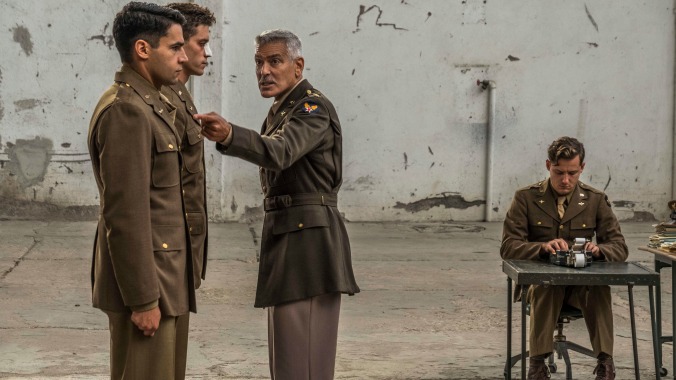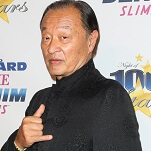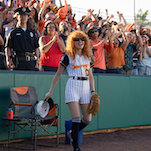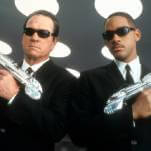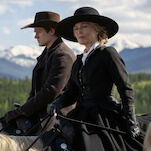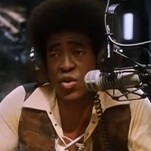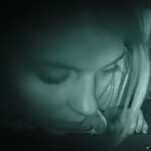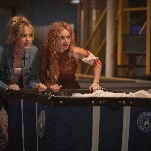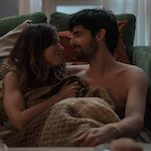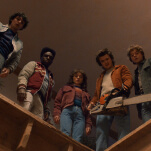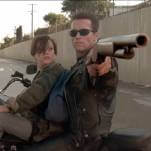Christopher Abbott (left), Pico Alexander, George Clooney, Lewis Pullman Photo: Philipe Antonello
It’s the confusion.
That’s the glue binding Joseph Heller’s Catch-22, the jet-black anti-war satire/stark military parade of nightmares that’s served as a rallying point for multiple generations of smart alecks. The contradictory nature of the U.S. Air Force bureaucracy, the circular manner in which the people surrounding bombardier John “YoYo” Yossarian speak, the mayhem of the Mediterranean theater of World War II—they’re what makes Catch-22 work, what allows an absurd surname like Aardvark to sit comfortably on the same pages that describe the monstrous actions of the character with the surname Aardvark. The novel walks a very fine line, and that line dips and dives and intersects with itself in ways that’ll leave heads aching, ribs sore, and tear ducts dry.
Hulu’s new Catch-22 miniseries might inspire similar feelings, minus the positive connotations. Minus the confusion, too: For one, writers Luke Davies and David Michôd untwist the novel’s chronology. They start their telling of Yossarian’s escapades at the beginning, when the airman (played by Christopher Abbott) is biding his time as a cadet, shtupping his commanding officer’s wife and operating under the assumption that the war will be over before he ever leaves flight training school. The trade-off for these dampened literary ambitions is that Catch-22 gets its major benefactor, director of two of its episodes, and biggest star into the premiere: After a brief feint toward disorder, the first clear voice in the sound mix is that of George Clooney, bearing the neatly trimmed mustache and raging perfectionism of the cuckolded Colonel Scheisskopf.
It’s the first indication that this will be a more straightforward version of Catch-22. The second comes as Yossarian and his fellow cadets receive pop-up name tags, not a preview of playful experiments in onscreen text to come, but rather a roll call for a cast that’s positively teeming with characters. It’s unfortunate: The closest the miniseries comes to replicating Heller’s integral sense of confusion is the interchangeability of the too-perfect 2010s faces populating its ranks.
Abbott’s print-editorial-ready mug is well suited for conveying Yossarian’s anguish as a discharge continually slips through his fingers and his friends wind up dead, missing, or some combination of the two. What those deep, soulful eyes are less equipped for is the comedy of the predicament, the maze of red tape and bomb-lines-as-defined-by-strings-on-maps that make the bombardier the unwitting pawn of prideful Colonel Cathcart (Kyle Chandler, playing the officer as a sort of mirror universe Coach Taylor). It’s a problem that infects most of Catch-22: Davies, Michôd, and the directing team of Clooney, Ellen Kuras, and Grant Heslov don’t seem to see what’s potentially funny about all of this, and some bright spots aside—moments of inspired physical comedy from the erstwhile Dr. Doug Ross; a properly crackling translation of the promotion and closed-door policy of the fortunately named Major Major Major (Lewis Pullman)—settle instead for a tone that’s less about the maddening pointlessness of war and more about its bloody horrors, complete with mournful instrumental score.
It’s like M*A*S*H, if that show kicked off at peak sanctimony; it’s Dunkirk with interludes of madcap war profiteering shenanigans starring the insidiously industrious mess officer Milo Minderbinder (Daniel David Stewart). Broadway vet Stewart is the only person enjoying themselves on-camera, rattling off soliloquies about the virtues of capitalism and explaining his wheelings and dealings while guns are pointed in his direction and bombs detonate in the background. He’s the grinning, morally compromised agent of chaos the miniseries needs, and could’ve used more of.
Instead, Catch-22 is defined by the sickly pallor of its visual palette (a jaundiced tint that at least goes with Yossarian’s point of view and phony liver pains) and the way it makes the slog of its characters’ deployment a little too literal. There’s palpable peril in the squadron’s ever-mounting bombing runs, and Cathcart’s moving target of a mission quota makes a clever parallel to contemporary America’s Forever War, but the flight sequences wind up acquiring a deadening repetitiousness. On the ground, there are reduced roles for the supporting cast of kooks stationed on the island of Pianosa. Hugh Laurie is on hand, but just barely, as horseshoe-pitching Major de Coverley; Jay Paulson is but a blip on the radar as the chaplain.
And while it occasionally conjures the knotty density of its source—typically during the novel’s most celebrated passages, like the one that explains its titular contradiction—the unifying absurdist jumble never falls totally into place. It’s uncommonly tricky material, much of its humor wrapped up in wordplay, many of its characters allegorical sketches. Hulu’s Catch-22 tries to address the latter by bumping up the pathos, but that just makes the miniseries less enjoyable to watch. (The Handmaid’s Tale is harrowing, too, but at least Reed Morano give it a visual distinctiveness. The fact that Catch-22 looks the way it does, despite a third of it being directed by the woman who shot Eternal Sunshine Of The Spotless Mind, is a real letdown.) Clooney and team aren’t the first to have Heller’s novel get the best of them; Mike Nichols and Buck Henry followed up their collaboration on The Graduate with a fascinatingly flawed (and also chronologically uncomplicated) big-screen Catch-22. Perhaps the real catch-22 is this: That a novel whose dialogue is begging to be spoken out loud, whose backdrop is so traditionally cinematic, is fundamentally unadaptable.
